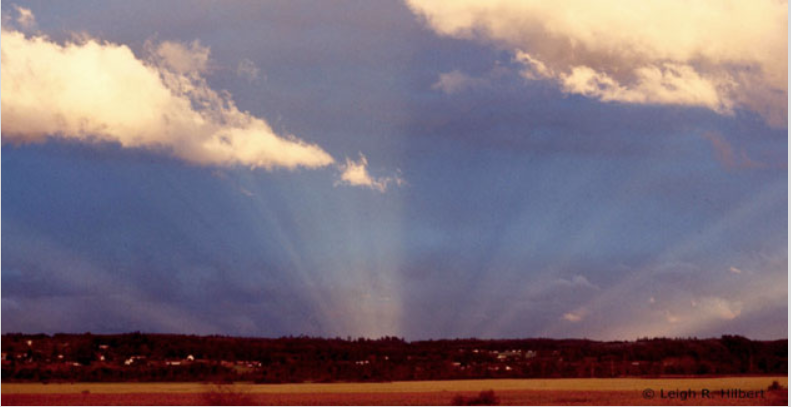Anticrepuscular Rays
Anticrepuscular Rays: A Spectacular Atmospheric Phenomenon
Have you ever witnessed rays of sunlight seemingly converging in the opposite direction of the setting sun? These fascinating rays, known as anticrepuscular rays, create a mesmerizing display in the sky. While crepuscular rays appear to converge on the sun itself, anticrepuscular rays appear to converge towards the antisolar point, which is directly opposite the sun in the sky.
To observe anticrepuscular rays, you must position yourself with your back to the sun or sunset point. As you gaze towards the horizon opposite the sun, you may be fortunate enough to witness these parallel shafts of sunlight streaming through gaps in the clouds. The seemingly peculiar directions of these rays are actually a result of perspective. Just like a straight road appears to converge towards the horizon, anticrepuscular rays appear to converge towards the opposite horizon.
While anticrepuscular rays are not necessarily rare, they do require careful observation. When you notice crepuscular rays illuminating the sky, it's time to turn around and search for their opposite counterparts. By shifting your focus away from the sun, you may be rewarded with the breathtaking sight of anticrepuscular rays stretching across the sky.
Although anticrepuscular rays are commonly seen as parallel beams of light, there are instances where they can pass directly across the sky. These rare occurrences enhance the awe-inspiring nature of this atmospheric phenomenon. It is truly a spectacle to witness sunlight traversing the celestial dome in such an unexpected manner.
The appearance of anticrepuscular rays is a result of sunlight passing through openings in clouds. As the sun's rays interact with water droplets or dust particles in the atmosphere, they scatter and create these radiant beams. The interplay between light and atmospheric particles is what gives rise to the mesmerizing patterns of anticrepuscular rays.
To fully appreciate the beauty of anticrepuscular rays, it is important to understand the concept of the antisolar point. This point is directly opposite the sun's position in the sky and serves as the focal point towards which the rays appear to converge. By visualizing this point, you can better grasp the dynamics of anticrepuscular rays and their relationship to the sun's position.
In addition to their aesthetic appeal, anticrepuscular rays also provide valuable insights into atmospheric conditions. The presence of these rays indicates the existence of gaps or holes in clouds through which sunlight can penetrate. By observing the formation and behavior of anticrepuscular rays, scientists can gain a deeper understanding of cloud structure and dynamics.
In conclusion, anticrepuscular rays are a captivating atmospheric phenomenon that delights those fortunate enough to witness them. By turning away from the sun and focusing on the horizon opposite its position, one can experience the awe-inspiring sight of parallel shafts of sunlight converging towards the antisolar point. Whether appearing as distinct beams or spanning across the sky, these rays serve as a reminder of the beauty and complexity of our atmosphere. So next time you find yourself basking in the glow of crepuscular rays, don't forget to turn around and explore the enchanting world of anticrepuscular rays.

Rays in the east opposite the setting sun the foreground and clouds are still sunlit. Leigh Hilbert (site) caught these anti-crepuscular rays on 3rd March 2004 in Washington State. ©2004 Leigh R. Hilbert shown with permission.
Crepuscular rays appear to converge on the sun, anticrepuscular or antisolar rays converge in the opposite direction and you must have your back to the sun or sunset point to see them. They appear to converge towards the antisolar point, the point on the sky sphere directly opposite the sun. Like crepuscular rays they are parallel shafts of sunlight from holes in the clouds and their apparently odd directions are a perspective effect. Think of a long straight road, it converges towards the horizon but turn around and it also converges to the opposite horizon. Crepuscular and anticrepuscular rays behave in the same way.
Anticrepuscular rays are not rare but they must be sought carefully. When ordinary crepuscular rays are visible, turn around and search for their opposite numbers. More rarely, sunrays pass right across the sky.
Note: this article has been automatically converted from the old site and may not appear as intended. You can find the original article here.
Reference Atmospheric Optics
If you use any of the definitions, information, or data presented on Atmospheric Optics, please copy the link or reference below to properly credit us as the reference source. Thank you!
-
<a href="https://atoptics.co.uk/blog/anticrepuscular-rays/">Anticrepuscular Rays</a>
-
"Anticrepuscular Rays". Atmospheric Optics. Accessed on December 18, 2024. https://atoptics.co.uk/blog/anticrepuscular-rays/.
-
"Anticrepuscular Rays". Atmospheric Optics, https://atoptics.co.uk/blog/anticrepuscular-rays/. Accessed 18 December, 2024
-
Anticrepuscular Rays. Atmospheric Optics. Retrieved from https://atoptics.co.uk/blog/anticrepuscular-rays/.